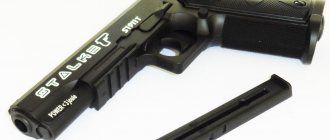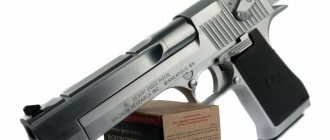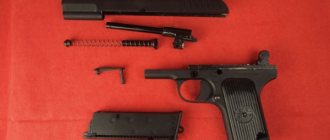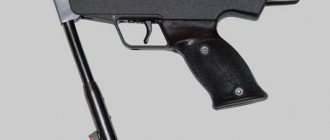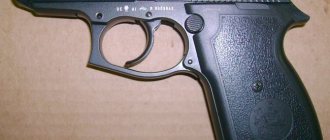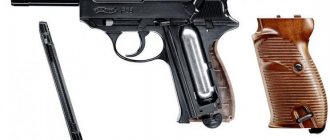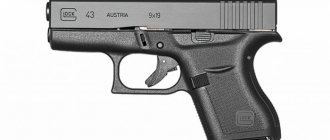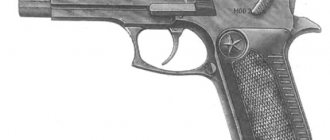When we hear the word Colt, our man immediately thinks of a cowboy with a huge revolver in his hand. Well, the words that Colonel Colt equalized everyone’s chances.
Yes, this pistol is a legend in America, and during this time many of its modifications have appeared. Including non-lethal ones. Like, for example, the pneumatic Gletcher CLT 1911.
Its prototype was the famous Colt M1911, developed in the 11th year of the last century by the no less famous Browning. The specified pistol was in service with the US army and police for more than seventy years, and only in 1985 it was replaced by the Beretta, but it was not removed from sale.
The popularity of this pistol was so high that it was used by the armies of other countries. Including in the Russian tsarist army, whose officers purchased it as a second weapon for their own money, preferring Colt instead of the standard Nagant. It is still in service in some armies.
The Glatcher pneumatic gun we are considering today is a complete copy of the Colt combat rifle from 1926. True, the plastic lining on the Glacier is from the 1940 model.
Description
The air pistol is made entirely of weapon steel, only the handles are made of plastic. This design has led to the fact that the pneumatic gun has a weight of 900 grams, which is considered quite a lot of weight for a weapon of this type. But for Colt lovers this is just right, although the weight does not reach the weight of a combat weapon, the Glacier gives the feeling of a real weapon in the hands.
The similarity is enhanced by the replica’s equipment with the BlowBack system or imitation of recoil when fired from a military weapon.
The Glacier 1911 is an air gun that uses gas cylinders with CO2 for firing, that is, it is a gas-cylinder type. Explosive balls, steel or copper-plated, are used as ammunition. The magazine includes 19 balls, but experienced users recommend equipping the clip with only 15 bullets; in this case, one can is enough for three such clips or 45 full shots.
The bullets are loaded in the standard way, from above. The gas cylinder is also installed in the holder; the membrane is punctured using a hidden clamping screw and a key included in the kit.
In the basic configuration, the shot energy is less than 3 J, this is confirmed by the certificate of conformity. Thanks to this fact, you can purchase a pistol without having the appropriate license.
Such power places the pistol in the middle class, and even then, according to many, it’s a stretch, since the bullet flies at a speed of only 100 m/s. This is only enough for normal shooting at 10 meters and that’s it. But all these mentioned shortcomings are more than offset by the bonuses transferred from the combat pistol.
The trigger mechanism has a single action, this requires cocking the hammer. Cocking can be done directly by hand, or by pulling the bolt. Subsequent shots are fired automatically, as the blowback will cock. As soon as the last bullet is shot, the frame locks onto the bolt stop.
Let us repeat once again: the pneumatic gun is a complete copy of its combat counterpart, which is also manifested in the safety system, consisting of two independent mechanisms.
Inventor Browning installed an automatic safety button in the form of a button on his brainchild, located on the handle of the pistol. In order to make a shot, you need to push it in, and to do this you will have to tightly “hug” the handle, often with both hands.
But the army acceptance team found this safety to be unreliable, so they insisted that the inventor also equip his pistol with a standard safety catch.
The sight is open and non-adjustable. According to users, this solution is somewhat strange for an air pistol, but everyone attributed this to the fact that the manufacturer focuses on full compliance with the combat prototype.
I couldn't find any reviews about this gun anywhere. Here https://sldru.livejournal.com/53054.html there is a good article, but there are few photos and not all points are mentioned. Therefore, I will be the first with a review.So:
Name: CLT 1911 Manufacturer: Gletcher Weapon type: CO2-powered air pistol with simulated bolt stroke when firing Caliber: 4.5 mm (steel or copper-plated balls) Total length: 220 mm Weight: 900 g Muzzle energy: no more than 3 J Average muzzle velocity bullets: 100 m/s Magazine capacity: 19 (according to the passport), 18 (I actually have) Number of shots from one cylinder: 50-60 Trigger: single action Safety: automatic and non-automatic Fire modes: semi-automatic Body made entirely of metal alloys, The cheeks of the handle and the gas engine are plastic. Delivery set: pistol, magazine, key for tightening the CO2 tank fixing screw, instructions in Russian Links: - combat prototype https://world.guns.ru/handguns/hg/usa/colt-govt-m1911-r.html - website manufacturer https://gletchergun.ru/catalog/AirGun/clt1911
Partial disassembly is identical to the original. Everything looks as usual, except for the spring on the outer barrel, like, for example, the PM. I don’t know why this was done (airsoft Colts don’t have this spring), but apparently it’s needed for something.
For comparison, incomplete disassembly of the review hero (above) and an airsoft Colt from Classic Army (below).
Well, one more comparison with the TT (MR-656K). This is a hint that our TT was made with an eye on other samples. There are similarities in the fastening of the barrel with the bolt stop lever, in the fastening of the return spring, in the part that covers the barrel in front of the bolt, etc. But all this does not detract from the merits of our TT.
An automatic mechanism with a short barrel stroke has been implemented. The photo shows the protrusions with which the outer barrel clings to the bolt. When the bolt rolls back, it pulls the barrel along with it, the breech of the barrel gradually goes down and disengages from the bolt. The barrel stops and the bolt continues to roll back.
The CLT 1911 does not implement a safety cocking mechanism, which on the original intercepts the hammer that breaks during cocking. In the following photos I compared it with the same airsoft Colt from Classic Army (below).
Both pistols have their triggers pulled.
On the CLT 1911 the hammer is fully cocked, while on the Classic Army Colt it is on the safety cock.
Both pistols have their hammers cocked.
And one more thing with non-automatic safety: on the CLT 1911 it works both with the hammer pulled and cocked, but on the Classic Army Colt it works only with the hammer fully cocked. Unfortunately, I don’t know how it works on the original. Everything is clear about the automatic fuse. So I’ll just say: it works.
The manufacturer did not adjust the thickness of the magazine to fit the CO2 cylinder, but made the magazine of its normal size with protruding sides of the cylinder. In my opinion, this is a good solution, because when you “play” with a pistol without a cylinder, it’s nice to feel the magazine of its original size, and when the cylinder is screwed in, these protrusions also don’t bother you much.
The ball feeder in the store had an undocumented function in the form of a delay in the down position. As it turns out, this is both good and bad at the same time. Good: convenient to load the magazine. Bad: the 19 balls stated in the passport do not allow the feeder to be removed from the stopper. And plus, if you load 18 balls, then when installing a magazine in a pistol with a closed bolt, the ball rammer into the barrel on the gas chamber pushes the feeder down to the size of the ball, and it again gets delayed. So the solution is this: load 18 balls into a magazine and insert the magazine into a pistol with a bolt on the slide stop.
Shooting. The returns, as noted in the article at the very top, are really good. Subjectively more than the GSG-92 from Cybergun. Which is understandable: the GSG-92’s shutter weighs just a feather. I wasn't particularly pleased with the accuracy. The spread of meters is from 3-4 in a circle of 5-6 cm. Sometimes it flies out of this circle. However, this is subjective, since I don’t consider myself a particularly good shooter, even though I shot with both hands. On the other hand, this is not a sports pistol, and you shouldn’t expect sports results from it. The pistol fires the first two magazines at full force. The third store is already feeling a drop in power. The fourth is already spitting. When the power drops, the pistol begins to hit noticeably below the sight.
Conclusions (subjective): - I haven’t found any glaring disadvantages yet - fans of hard pneumatics and Colt 1911s should definitely have this pistol
If I forgot to mention something, I am ready to answer additional questions.
Wearing Features
The pneumatic analogue of the combat barrel is worn in two ways:
- Traditionally, in this case the chamber is empty. To fire, the bolt is cocked by chambering the cartridge, which then cocks the hammer and the shot can be fired. As can be seen from the description, our pneumatic gun is also equipped with a movable shutter. So all the above actions apply to him too. This method of wearing is also called civilian.
- The second method is the army one. In this case, the cartridge is immediately sent into the chamber. The trigger is in the safety cocked position with the safety off. I cocked the hammer and the pistol was ready to fire.
In the latter case, there is no need to be afraid of the safety cocking of the hammer; the safety of the pistol is higher than if it were in a deflated state. After all, even if the weapon falls, an accidental shot is completely excluded. In addition, do not forget about the automatic fuse. Without pressing it, there will be no shot, even if the flag is lowered.
Advantages and disadvantages
One of the main advantages is that it almost completely replicates its combat counterpart, which is quite rare for air weapons.
Experts and users consider the second advantage for the pistol to be the mobility of the bolt and the Blowback system. This allows the shooter to feel the recoil of the shot. Although not like the original, but approximately the same as a small-sized firearm, this ability of the pistol makes it feel very close to a firearm.
Usually they shoot from a pneumatic gun at 10-12 meters. The pistol we are considering allows you to do this at a distance of up to 20 meters. Naturally making an adjustment for distance.
Many people note the safety of the pistol. The mechanical safety works both when the trigger is pulled and cocked, but the automatic safety must be pressed consciously. There will be no shot from accidental pressing.
The ball feeder may have a delay in the down position, this feature is not documented. It is both a plus and a minus at the same time.
- The advantage is that it is very convenient to equip the magazine in this position.
- The downside is that if you equip the clip with the indicated 19 balls, the feeder will never be able to remove itself from the stopper.
Practice has shown that it is best to load 18 balls into a clip and insert it into the pistol on the slide stop.
The disadvantages include the large spread of bullets on the target, although, according to numerous reviews, there is little confirmation of this.
Many owners are concerned that with a new cylinder, the pistol normally fires two clips, but on the third, a drop in the power of the shot is already felt. You don’t have to shoot the fourth clip, since instead of full-fledged shots you get so-called spitting shots, when the shots go much lower than the sight.
Review of the Gletcher CLT 1911 pistol
The COLT 1911, designed by John Moses Browning and produced by Samuel Colt, was introduced into service with the US Army. To mark the centenary of the famous pistol, a model of an automatic pistol was released - an exact version of its firearms older brother. The dimensions of the original gun have been maintained and the finish is consistent with known standard Colt products. The model is made entirely of high-quality cast metal, which ensures the accuracy and durability of the system, the cheeks of the handle and the gas engine are plastic, imitating the original wood
The pistol is equipped with a Blowback system - after a shot, the pistol bolt moves back and cocks the hammer - everything is ready for a new shot. Fits in perfectly.
The magazine, designed for 19 spherical bullets of 19 4.5mm, is inserted as in the combat version. The window for the 12 g can takes up most of the magazine. To install and remove the cylinder, a hex wrench is used to unscrew and lock the clamping screw located at the bottom of the magazine. It is very convenient that the heel of the magazine does not protrude beyond the handle. Nice improvement.
The bolt is also weighted; movement of the bolt is only possible when the safety is removed. Compared to the original, the cocking force of the shutter is noticeably less.
With partial disassembly, everything corresponds to the original. The exception is the spring on the outer barrel. Most likely this is a shock absorber to reduce the impact in the rear position of the bolt.
Let's shoot!
Due to its dimensions - a kilogram of metal with a total length of 220 mm - it is not possible to transport the pistol in a pocket. Required to be treated with dignity - placed in a bag or holster. Although, many people like the massiveness of the weapon.
The aiming devices are: a small slot in the fixed rear sight and a low front sight. When fired, the pistol recoils, thanks again to Blowback. Of course, it doesn’t reach the powerful shock of a real bullet, but it’s also a pleasure. The shooting accuracy characteristic of this type of weapon allows you to confidently crush tin cans from 5-7 meters.
Accurate shooting is also possible from a distance of 20 meters with a slight adjustment. One can will give you 50-70 shots. The returns, as noted above, are quite satisfying.
The maximum speed with the new cylinder is only 102 m/s. Shooting one magazine charge (18 balls) results in a drop in speed to 86 m/s.
The accuracy is quite good. The spread from 3-4 meters in a circle is 2-3 cm. Sometimes it flies out of this circle. It is incorrect to expect sporting results from a non-sports pistol.
The Colt has plenty of power. Completes its tasks 100%
Disassembly
Disassembly can be complete or incomplete. To help the owner, the manufacturer includes an explosion diagram in the kit.
In conclusion, let's say the following. Glacier can be considered a complete, but still a copy of the original Colt 1911, and of excellent quality. It has nothing extra or missing, everything is balanced and works.
Recommended for country target shooting. You can take part in hardball with it. Some people keep it as a toy.
You can ignore minor flaws in the form of build quality. After all, according to experts, there will be no equal in its class on the market for a long time.
Air gun Gletcher TT NBB 4.5 mm
The Gletcher TT NBB air pistol is a gas-cylinder pneumatic from the renowned manufacturer of air pistols Gletcher. The design of the pistol completely replicates the design of the post-war TT (Tula Tokarev) pistols, which were in service in our country until the 2000s, and in some countries are used by troops and special forces to this day. The pistol has a metal body and weighs 600g. Double action pistol trigger mechanism. The sights are open - rear sight and front sight. The bolt frame of gletcher nbb air pistols does not move when firing, there is no Blowback function. The original model is famous for its simplicity and reliability in operation; it was this principle that was used as the basis for the design of its pneumatic “brother”. The difference between the pneumatic TT and the original is the thickened plastic lining on the handle, this was done for greater comfort. Indeed, every person who understands weapons will say this. Considering the high shooting performance and affordable price, this makes the Gletcher TT NBB an excellent weapon option for novice shooters. Standard steel balls with a diameter of 4.5 mm are used as pistol bullets. The magazine holds 18 of these bullets. Shooting is possible both by self-cocking and in pre-cocking mode. The target firing range is about 15 meters, and the initial bullet speed is 125 m/s. A standard 12 gram carbon dioxide canister is used as an energy source for the shot.
The manufacturer may make changes to the contents, color, design and/or software of the product without prior notice to users.
Buy a Gletcher TT NBB 4.5 mm air pistol for RUB 6,569 in the MOSOKHOTA hunting store or order by phone.
Pay for purchases online, by credit card or cash on delivery upon receipt. You can order a Gletcher TT NBB 4.5 mm air pistol and receive fast, convenient and inexpensive delivery by courier or to a delivery point in the following cities and regions of Russia:
- CITIES OF RUSSIA:
- Abakan
- Azov
- Aksai
- Alexandrov
- Alushta
- Almetyevsk
- Anapa
- Arzamas
- Armavir
- Artem
- Arkhangelsk
- Astrakhan
- Achinsk
- Bagan
- Balakovo
- Balakhna
- Balashikha
- Barnaul
- Bataysk
- Belgorod
- Belovo
- Berdsk
- Berezniki
- Biysk
- Birobidzhan
- Blagoveshchensk
- Bolotnoe
- Borovichi
- Bratsk
- Bryansk
- Butovo (Moscow)
- Velikie Luki
- Velikiy Novgorod
- Vengerovo
- Vidnoe
- Vladivostok
- Vladikavkaz
- Vladimir
- Volgograd
- Volgodonsk
- Volzhsky
- Vologda
- Volokolamsk
- Voronezh
- Vsevolozhsk
- Vyborg
- Vyazma
- Gatchina
- Gelendzhik
- Georgievsk
- Glazov
- Gorno-Altaisk
- Grozny
- Gubkin
- Dzerzhinsk
- Dimitrovgrad
- Dmitrov
- Satisfied
- Dolgoprudny
- Dubna
- Evpatoria
- Ekaterinburg
- Elizovo
- Essentuki
- Railway
- Zhukovsky
- Zabaikalsk
- Zvenigorod
- Zdvinsk
- Zelenograd
- Zelenodolsk
- Zernograd
- Zlatoust
- Ivanovo
- Ivanteevka
- Izhevsk
- Irkutsk
- Iskitim
- Istra
- Yoshkar-Ola
- Kazan
- Kaliningrad
- Kaluga
- Kamensk-Shakhtinsky
- Kansk
- Karasuk
- Kargath
- Kemerovo
- Kerch
- Kingisepp
- Kineshma
- Kirishi
- Kirov
- Kiselevsk
- Kislovodsk
- Wedge
- Klintsy
- Kovrov
- Kolomna
- Kolpino
- Komsomolsk-on-Amur
- Kopeisk
- Korolev
- Kostroma
- hummocks
- Krasnogorsk
- Krasnodar
- Krasnoobsk
- Krasnoturinsk
- Krasnoufimsk
- Krasnoyarsk
- Kuibyshev
- Kungur
- Kupino
- Mound
- Kursk
- Kyshtovka
- Labinsk
- Leninsk-Kuznetsky
- Lermontov
- Lipetsk
- Lobnya
- Lyubertsy
- Lyudinovo
- Magadan
- Magnitogorsk
- Maykop
- Makhachkala
- Megion
- Mezhdurechensk
- Miass
- Mineral water
- Mikhailovsk
- Mozhaisk
- Moscow
- Mitino (Moscow)
- Moskovsky (Moscow)
- Murmansk
- Moore
- Mytishchi
- Naberezhnye Chelny
- Nadym
- Nalchik
- Naryan-Mar
- Nakhodka
- Nevinnomyssk
- Neryungri
- Neftekamsk
- Nefteyugansk
- Nizhnevartovsk
- Nizhnekamsk
- Nizhny Novgorod
- Nizhny Tagil
- Nizhnyaya Tura
- Novoaltaysk
- Novokuznetsk
- Novomoskovsk
- Novorossiysk
- Novosibirsk
- Novouralsk
- Novocheboksarsk
- Novocherkassk
- Novoshakhtinsk
- New Urengoy
- Noginsk
- Norilsk
- Noyabrsk
- Nyagan
- Obninsk
- Odintsovo
- October
- Omsk
- Ordynskoe
- Eagle
- Orenburg
- Orekhovo-Zuevo
- Orsk
- Penza
- Pervouralsk
- Permian
- Petrozavodsk
- Petropavlovsk-Kamchatsky
- Podolsk
- Prokopyevsk
- Pskov
- Pushkino
- Pyatigorsk
- Ramenskoye
- Rostov-on-Don
- Rubtsovsk
- Rumyantsevo
- Rybinsk
- Ryazan
- Salavat
- Salekhard
- Samara
- Saint Petersburg
- Saransk
- Saratov
- Sarov
- Sevastopol
- Northern
- Seversk
- Sergiev Posad
- Serov
- Serpukhov
- Simferopol
- Slavyansk-on-Kuban
- Smolensk
- Snezhinsk
- Soviet
- Solnechnogorsk
- Solntsevo
- Pinery
- Sochi
- Stavropol
- Stary Oskol
- Sterlitamak
- Strezhevoy
- Stupino
- Zander
- Suzun
- Surgut
- Sizran
- Syktyvkar
- Taganrog
- Tambov
- Tver
- Tikhvin
- Tobolsk
- Toguchin
- Tolyatti
- Tomsk
- Troitsk
- Tula
- Tyumen
- Ubinskoe
- Ulan-Ude
- Ulyanovsk
- Ussuriysk
- Ust-Tarka
- Ufa
- Ukhta
- Uchaly
- Feodosia
- Khabarovsk
- Khanty-Mansiysk
- Khasavyurt
- Khimki
- Chaikovsky
- Vats
- Cheboksary
- Chelyabinsk
- Cherepovets
- Cherkessk
- Chekhov
- Chistoozernoe
- Chita
- Chulym
- Chusovoy
- Mines
- Shchelkovo
- Elektrostal
- Elista
- Engels
- Yuzhno-Sakhalinsk
- Yuzhnouralsk
- Yurga
- Yuryuzan
- Yakutsk
- Yalta
- Yaroslavl
- Yartsevo
- and other cities.
- REGIONS OF RUSSIA:
- Altai region
- Amur region
- Arhangelsk region
- Astrakhan region
- Belgorod region
- Bryansk region
- Vladimir region
- Volgograd region
- Vologda Region
- Voronezh region
- Jewish Autonomous Region
- Transbaikal region
- Ivanovo region
- Irkutsk region
- Kabardino-Balkarian Republic
- Kaliningrad
- Kaluga region
- Kamchatka Krai
- Karachay-Cherkess Republic
- Kemerovo region
- Kirov region
- Kostroma region
- Krasnodar
- Krasnoyarsk region
- Kurgan region
- Kursk region
- Leningrad region
- Lipetsk region
- Magadan Region
- Moscow region
- Murmansk region
- Nizhny Novgorod Region
- Novgorod region
- Novosibirsk region
- Omsk region
- Orenburg region
- Oryol Region
- Penza region
- Perm region
- Primorsky Krai
- Pskov region
- Republic of Adygea
- Altai Republic
- Republic of Bashkortostan
- The Republic of Buryatia
- The Republic of Dagestan
- The Republic of Ingushetia
- Republic of Kalmykia
- Republic of Karelia
- Komi Republic
- Republic of Crimea
- Mari El Republic
- The Republic of Mordovia
- The Republic of Sakha (Yakutia)
- Republic of North Ossetia (Alania)
- Republic of Tatarstan
- Tyva Republic
- The Republic of Khakassia
- Republic of Chechnya
- Rostov region
- Ryazan Oblast
- Samara Region
- Saratov region
- Sakhalin region
- Sverdlovsk region
- Smolensk region
- Stavropol region
- Tambov Region
- Tver region
- Tomsk region
- Tula region
- Tyumen region
- Udmurt republic
- Ulyanovsk
- Khabarovsk region
- Chelyabinsk region
- Chuvash Republic
- Yaroslavl region
